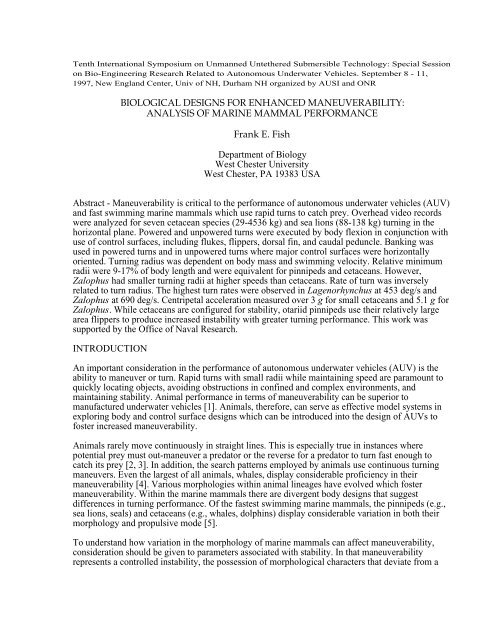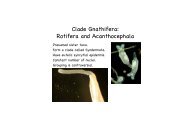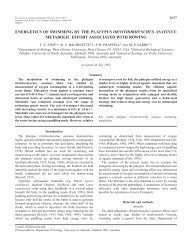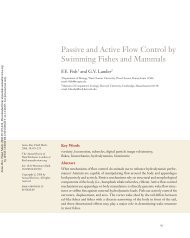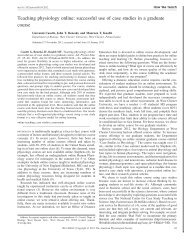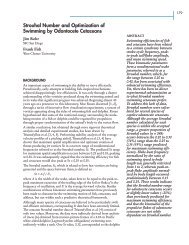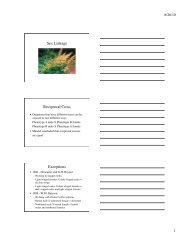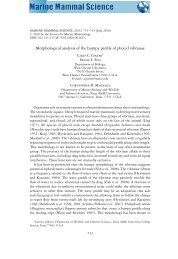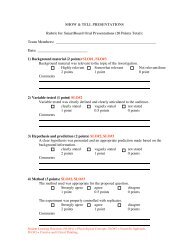Tenth International Symposium on Unmanned Untethered ...
Tenth International Symposium on Unmanned Untethered ...
Tenth International Symposium on Unmanned Untethered ...
You also want an ePaper? Increase the reach of your titles
YUMPU automatically turns print PDFs into web optimized ePapers that Google loves.
<str<strong>on</strong>g>Tenth</str<strong>on</strong>g> <str<strong>on</strong>g>Internati<strong>on</strong>al</str<strong>on</strong>g> <str<strong>on</strong>g>Symposium</str<strong>on</strong>g> <strong>on</strong> <strong>Unmanned</strong> <strong>Untethered</strong> Submersible Technology: Special Sessi<strong>on</strong><strong>on</strong> Bio-Engineering Research Related to Aut<strong>on</strong>omous Underwater Vehicles. September 8 - 11,1997, New England Center, Univ of NH, Durham NH organized by AUSI and ONRBIOLOGICAL DESIGNS FOR ENHANCED MANEUVERABILITY:ANALYSIS OF MARINE MAMMAL PERFORMANCEFrank E. FishDepartment of BiologyWest Chester UniversityWest Chester, PA 19383 USAAbstract - Maneuverability is critical to the performance of aut<strong>on</strong>omous underwater vehicles (AUV)and fast swimming marine mammals which use rapid turns to catch prey. Overhead video recordswere analyzed for seven cetacean species (29-4536 kg) and sea li<strong>on</strong>s (88-138 kg) turning in thehoriz<strong>on</strong>tal plane. Powered and unpowered turns were executed by body flexi<strong>on</strong> in c<strong>on</strong>juncti<strong>on</strong> withuse of c<strong>on</strong>trol surfaces, including flukes, flippers, dorsal fin, and caudal peduncle. Banking wasused in powered turns and in unpowered turns where major c<strong>on</strong>trol surfaces were horiz<strong>on</strong>tallyoriented. Turning radius was dependent <strong>on</strong> body mass and swimming velocity. Relative minimumradii were 9-17% of body length and were equivalent for pinnipeds and cetaceans. However,Zalophus had smaller turning radii at higher speeds than cetaceans. Rate of turn was inverselyrelated to turn radius. The highest turn rates were observed in Lagenorhynchus at 453 deg/s andZalophus at 690 deg/s. Centripetal accelerati<strong>on</strong> measured over 3 g for small cetaceans and 5.1 g forZalophus. While cetaceans are c<strong>on</strong>figured for stability, otariid pinnipeds use their relatively largearea flippers to produce increased instability with greater turning performance. This work wassupported by the Office of Naval Research.INTRODUCTIONAn important c<strong>on</strong>siderati<strong>on</strong> in the performance of aut<strong>on</strong>omous underwater vehicles (AUV) is theability to maneuver or turn. Rapid turns with small radii while maintaining speed are paramount toquickly locating objects, avoiding obstructi<strong>on</strong>s in c<strong>on</strong>fined and complex envir<strong>on</strong>ments, andmaintaining stability. Animal performance in terms of maneuverability can be superior tomanufactured underwater vehicles [1]. Animals, therefore, can serve as effective model systems inexploring body and c<strong>on</strong>trol surface designs which can be introduced into the design of AUVs tofoster increased maneuverability.Animals rarely move c<strong>on</strong>tinuously in straight lines. This is especially true in instances wherepotential prey must out-maneuver a predator or the reverse for a predator to turn fast enough tocatch its prey [2, 3]. In additi<strong>on</strong>, the search patterns employed by animals use c<strong>on</strong>tinuous turningmaneuvers. Even the largest of all animals, whales, display c<strong>on</strong>siderable proficiency in theirmaneuverability [4]. Various morphologies within animal lineages have evolved which fostermaneuverability. Within the marine mammals there are divergent body designs that suggestdifferences in turning performance. Of the fastest swimming marine mammals, the pinnipeds (e.g.,sea li<strong>on</strong>s, seals) and cetaceans (e.g., whales, dolphins) display c<strong>on</strong>siderable variati<strong>on</strong> in both theirmorphology and propulsive mode [5].To understand how variati<strong>on</strong> in the morphology of marine mammals can affect maneuverability,c<strong>on</strong>siderati<strong>on</strong> should be given to parameters associated with stability. In that maneuverabilityrepresents a c<strong>on</strong>trolled instability, the possessi<strong>on</strong> of morphological characters that deviate from a
design which maintains stability is expected to enhance turning performance. Based <strong>on</strong> analysis ofaerodynamics, the following features are associated with stability [6, 7]:1. C<strong>on</strong>trol surfaces located far from the center of gravity2. C<strong>on</strong>centrati<strong>on</strong> of c<strong>on</strong>trol surface area posterior of center of gravity3. Anterior placement of center of gravity4. Dihedral of c<strong>on</strong>trol surfaces5. Sweep of c<strong>on</strong>trol surfaces6. Reduced moti<strong>on</strong> of c<strong>on</strong>trol surfaces7. Reduced flexibility of bodyIf we compare the placement and design of c<strong>on</strong>trol surfaces <strong>on</strong> sea li<strong>on</strong>s and cetaceans (Fig. 1), wesee marked differences between the two groups. The c<strong>on</strong>trol surfaces of sea li<strong>on</strong>s are representedby fore- and hindflippers with the larger foreflippers near the center of gravity. Because of the highmobility of the foreflippers, both the sweep and the dihedral of the flippers is variable. For thecetaceans, the flippers, flukes, dorsal fin, and caudal peduncle are the c<strong>on</strong>trol surfaces with the moremobile surfaces distance from the center of gravity. The flippers, flukes, and dorsal fin, whenpresent, can be highly sweep, particularly in the faster species.Flexibility in the body of cetaceans is generally c<strong>on</strong>strained [8]. In comparis<strong>on</strong>, pinnipeds displaysignificant axial flexibility [9].Comparis<strong>on</strong> of the morphology between pinnipeds and cetaceans suggests the whales anddolphins have a more stable design than marine mammals such as sea li<strong>on</strong>s. Therefore, it ispredicted that pinnipeds will be more highly maneuverable compared to cetaceans.MATERIALS AND METHODSTo study variati<strong>on</strong> in maneuverability based <strong>on</strong> differing body and c<strong>on</strong>trol surface morphologiesand propulsive modes, I examined the turning performance of eight species of marine mammals(seven cetaceans, <strong>on</strong>e pinniped) with different swimming capabilities. All were captive animalswhich were maintained in pools at various research and zoological facilities including Sea World,Pittsburgh Zoo, and L<strong>on</strong>g Marine Laboratory of the University of California Santa Cruz.For the cetaceans, these included the bottlenose dolphin (Tursiops truncatus), killer whale (Orcinusorca), Commers<strong>on</strong>'s dolphin (Cephalorhynchus commers<strong>on</strong>ii), Pacific white-sided dolphin(Lagenorhynchus obliquidens), false killer whale (Pseudorca crassidens), beluga (Delphinapterusleucas), and Amaz<strong>on</strong> river dolphin (Inia geoffrensis). Orcinus was the largest cetacean with <strong>on</strong>eindividual of 4536 kg; whereas the smallest at 29 kg was Cephalorhynchus. Pseudorca andLagenorhynchus are regarded generally as fast swimmers; whereas, Delphinapterus and Inia arec<strong>on</strong>sidered to be slow swimmers. Delphinapterus and Inia are different from the other cetaceans bypossessing mobile necks and flippers. Inia is capable of a notable degree of lateral flexi<strong>on</strong>. Inadditi<strong>on</strong>, the dorsal fin is reduced in Inia or absent in Delphinapterus. The cetaceans all useoscillati<strong>on</strong>s of the caudal flukes in the vertical plane for propulsi<strong>on</strong> [4, 5]. Analysis ofmaneuverability has not been performed previously.
Minimum Radius (m)101radius-poweredradius-unpoweredradius sea li<strong>on</strong>.110100100010000Mass (kg)Fig. 2. Minimum turning radius plotted against body mass for individuals. Circles represent cetaceans for poweredand unpowered turns and triangles represent Zalophus.
10Minimum Radius (body lengths)1.1.011radius-poweredradius-unpoweredradius-sea li<strong>on</strong>2 3 4567Body Length (m)Fig. 3. Minimum length-specific turning radius plotted against body length for individuals. Circles representcetaceans for powered and unpowered turns and triangles represent Zalophus.The single pinniped species was represented by the California sea li<strong>on</strong> (Zalophus californianus).This animal swims by oscillati<strong>on</strong>s of the paired foreflippers [5]. Analysis of turning performancewas restricted previously to descripti<strong>on</strong>s of gross movements of the body and appendages duringturning [10, 11], but no data were collected <strong>on</strong> performance capabilities.Animals were videotaped with a camcorder (Panas<strong>on</strong>ic DV-510) as they executed turningmaneuvers at or near the water surface under the directi<strong>on</strong> of their trainers. These maneuvers wereobserved through a glass wall for a lateral view underwater to detail the moti<strong>on</strong> of the c<strong>on</strong>trolsurfaces. To collect data <strong>on</strong> turning performance (e.g., radius, turning rate), a dorsal view of the turnwas recorded by positi<strong>on</strong>ing the video camera above the animal's pool. Distance above the poolvaried with the physical layout of the facility and size of the animal. Vertical distance of the cameraand observer over the water surface ranged from approximately 2 m to 10 m. Prior to swimmingtrials, animals were measured and marked with zinc oxide dots, which served as reference pointsand scale. One marker was placed at the approximate positi<strong>on</strong> above or lateral to the center ofgravity.Video records of the dorsal view were analyzed frame-by-frame at 30 Hz with a video recorder(Panas<strong>on</strong>ic AG-7300). Only those records were used in which the animal's body remainedhoriz<strong>on</strong>tal through the turn. The sequential positi<strong>on</strong>s of the center of gravity marker were recorded
<strong>on</strong>to transparencies from the video m<strong>on</strong>itor. The center of rotati<strong>on</strong> of the turn was determinedgeometrically. This technique allowed for determinati<strong>on</strong> of the trajectory of the center of gravity,despite distorti<strong>on</strong> in observing the actual positi<strong>on</strong> of the marker due to refracti<strong>on</strong> from surfacewaves. Turning radius, r, and average velocity, v, were measured, and centripetal accelerati<strong>on</strong>, ac, ings was computed according to:Angular displacement was used to calculate the turning rate in deg/s.RESULTSac = v 2 /r 9.8. (1)Observati<strong>on</strong>s of cetaceans showed two turning patterns: powered and unpowered. Powered turnswere defined as turns in which the animal was c<strong>on</strong>tinuously propelling itself by the dorso-ventraloscillati<strong>on</strong>s of the flukes; whereas in unpowered turns, the animal glided through the turn withoutapparent use of the caudal propulsor. Turns were initiated from the anterior of the animal withlateral flexi<strong>on</strong> of the head and rotati<strong>on</strong> of the flippers into the turn. The flippers also were adducted.During unpowered turns, substantial lateral flexi<strong>on</strong> of the peduncle was observed in additi<strong>on</strong> totwisting at the base of the flukes. The twisting acti<strong>on</strong> depressed the inner fluke tip. Some inwardbanking was observed during unpowered turns. Oscillati<strong>on</strong> around the l<strong>on</strong>gitudinal axis occurredduring powered turns that were associated with the propulsive fluke moti<strong>on</strong>s and produced a rollingmovement.Both Inia and Delphinapterus proved to be excepti<strong>on</strong>s to the general cetacean turning pattern. Iniashowed no tendency to bank during turns, instead using its flexible body to produce the turn.Delphinapterus, without a dorsal fin, would bank 90 o with its ventral surface facing into the turn.Zalophus used <strong>on</strong>ly unpowered turns. As previously described [11], The anterior end of the animalinitiates the turn as the sea li<strong>on</strong> rolls 90 o so that the ventral (abdominal) surface faces the outside ofthe turn. The body is flexed dorsally. The fore- and hindflippers are abducted and held in thevertical plane. This maneuver brings the full area of the flippers into use. In additi<strong>on</strong>, the positi<strong>on</strong> ofthe foreflippers is set to execute a power stroke and accelerate the sea li<strong>on</strong> as it comes out of theturn.
10CephalorhynchusDelphinapterusIniaLagenorhynchusOrcinusPseudorcaTursiopsZalophusVelocity1(lengths/s)0.10.01 0.1 1 10Radius (lengths)Fig. 4. Average length-specific velocity in relati<strong>on</strong> to length-specific turning radius. Polyg<strong>on</strong>s are drawn around datafor cetaceans and around data for Zalophus. The single point outside the cetacean polyg<strong>on</strong> represents a 1725.2 kg,5.05 m Orcinus which was able to produce a turn radius of 4 % of body length by ventrally flexing the posterior halfof the body The flukes were used to pivot the animal around its l<strong>on</strong>gitudinal axis.The force necessary to maintain a curved trajectory of a given radius is directly related to the squareof the velocity and the mass of the body [12]. Indeed, minimum turning radius plotted forindividuals was associated with body mass (Fig. 2). Unpowered turns for cetaceans had smallerminimum radii than powered turns for the same individuals. When scaled to body length, cetaceansgenerally dem<strong>on</strong>strated minimum unpowered turning radii of < 50% of body length (Fig. 3).Minimum radii within each species ranged from 11 to 17% of body length. These results arecomparable to maneuvers by fish and penguins [1, 3, 13, 14].Minimum unpowered turn radii for the two individuals of Zalophus were 0.16 and 0.28 m,representing 9 and 16% of body length, respectively. While the length-specific radii were small,they were not substantially different from similar values for cetaceans (Fig. 2, 3).However, different levels of performance between species were indicated when all the data forturning radius were plotted as a functi<strong>on</strong> of velocity (Fig. 4). The cetaceans displayed varyingcapabilities. Inia and Delphinapterus produced low-speed, small radius turns. Faster speed butlarger radius turns were performed by Lagenorhynchus and Cephalorhynchus and intermediateperformance was displayed by Orcinus, Pseudorca and Tursiops. Zalophus was able to makesmall radius turns while at high speed (up to 4.5 m/s).
65CephalorhynchusDelphinapterusIniaLagenorhynchusOrcinusPseudorcaTursiopsZalophus4Accelerati<strong>on</strong> (g)32100 100 200 300 400 500 600 700Turning Rate (deg/s)Fig. 5. Relati<strong>on</strong>ship between centripetal accelerati<strong>on</strong> and turning rate. Polyg<strong>on</strong>s are drawn around data for cetaceansand around data for Zalophus.The performance limits for turning are illustrated in Fig. 5 by a plot of centripetal accelerati<strong>on</strong> andturning rate. Most data for cetaceans is clustered at accelerati<strong>on</strong>s < 1.5 g with turning rates < 200deg/s. Individuals of Cephalorhynchus and Lagenorhynchus were able to exceed these lower valuesfor cetaceans with Lagenorhynchus displaying the maximum performance with an accelerati<strong>on</strong> of3.6 g and turning rate of 453 deg/s during unpowered turns. However, Zalophustypically exceeded even these maximal performances by cetaceans. One animal was able to executea 5.13 g turn at 690 deg/s.With the excepti<strong>on</strong> of high-performance aircraft (e.g., F-15, F-16) marine mammals meet or exceedthe centripetal accelerati<strong>on</strong>s of manufactured devices (Fig. 6). However, Zalophus was able toachieve an accelerati<strong>on</strong> greater than that experienced during lift-off <strong>on</strong> the space shuttle, whereas,Lagenorhynchus and Cephalorhynchus with maximum centripetal accelerati<strong>on</strong>s of approximately3 g were equivalent. Other cetaceans exhibited generally lower performance, although still higherthan small underwater vehicles [1]. The lowest centripetal accelerati<strong>on</strong>s occurred in Inia followed byDelphinapterus which both swam slowly during testing.Marine mammals generally show a high level of performance with regard to turning. Thisperformance, however, varies between species and between major tax<strong>on</strong>omic groups relating to theecology and the morphology of the animals. Maneuverability by marine mammals is dependent <strong>on</strong>body size, body stiffness and use of c<strong>on</strong>trol surfaces. The body stiffness and positi<strong>on</strong> and size ofthe c<strong>on</strong>trol surface, in particular, determine the stability of the animal when swimming. The sea li<strong>on</strong>,Zalophus, exhibits few adaptati<strong>on</strong>s for stability and is able to execute tighter turns at higher ratesthan cetaceans. The highly flexible body and mobile c<strong>on</strong>trol surfaces (e.g., fore- and hindflippers)aid in rapidly producing instability for turning. The large area of the flippers aid during the turn bypreventing side-slip [11].
F-15F-16+Mercury-AtlasSpace ShuttleZalophusLagenorhynchusCephalorhynchusTursiopsOrcinusPseudorcaDelphinapterusInia0 2 4 6 8 10gFig. 6. Comparis<strong>on</strong> of centripetal accelerati<strong>on</strong>s, g, of high-performance crafts and marine mammals.C<strong>on</strong>versely, cetaceans have a morphology that enhances stability thereby c<strong>on</strong>straining turningperformance. Cetaceans with flexible bodies and mobile flippers (e.g., Inia, Delphinapterus)sacrifice speed for maneuverability, whereas species with more restricted morphologies (e.g.,Lagenorhynchus, Cephalorhynchus) produce faster but wider turns. The dual functi<strong>on</strong> of thecaudal appendages for both turning and propulsi<strong>on</strong> presents a restricti<strong>on</strong> to simultaneouslymaintain high speed during tight turns. To produce a small turn radius, cetaceans must useunpowered maneuvers by uncoupling the c<strong>on</strong>trol surfaces from thrust producti<strong>on</strong> and limits speedand accelerati<strong>on</strong> after the turn. During unpowered turns, the peduncle and flukes are diverted fromtheir propulsive orientati<strong>on</strong> and used like a rudder.The enhanced maneuverability of sea li<strong>on</strong>s thus allows them to operate in restricted, in-shore waterswith complex envir<strong>on</strong>ments, whereas the more stable design of cetaceans limit these animals toswimming and foraging in more pelagic habitats. In additi<strong>on</strong>, the limitati<strong>on</strong>s of the cetacean designmay be a causative reas<strong>on</strong> for the use of cooperative foraging behaviors by whales and dolphins.The potential scientific and technological significance of this research is an understanding of thebasic turning performance by large aquatic organisms and the use and design of c<strong>on</strong>trol surfaces.The morphology and turning performance displayed by marine mammals suggest future avenuesfor the design of faster and more highly maneuverable aut<strong>on</strong>omous underwater vehicles (AUV).ACKNOWLEDGMENT: I gratefully acknowledge the cooperati<strong>on</strong> and assistance of the pers<strong>on</strong>alassociated with this project from Sea World, University of California Santa Cruz, Pittsburgh Zoo,Smiths<strong>on</strong>ian Instituti<strong>on</strong>, Brown University, and West Chester University. This work was sp<strong>on</strong>soredby ONR under grant #N00014-95-1-1045.REFERENCES[1] Bandyopadhyay, P. R., J. M. Castano, J. Q. Rice, R. B. Philips, W. H. Nedderman, and W. K.Macy. 1997. Low-speed maneuvering hydrodynamics of fish and small underwater vehicles. Trans.ASME 119: 136-144.
[2] Howland, H. C. 1974. Optimal strategies for predator avoidance: The relative importance ofspeed and manoeuvrability. J. theor. Biol. 47: 333-350.[3] Webb, P. W. 1983. Speed, accelerati<strong>on</strong> and manoeuvrability of two teleost fishes. J. exp. Biol.102: 115-122.[4] Fish, F. E., and J. M Battle. 1995. Hydrodynamic design of the humpback whale flipper. J.Morph. 225: 51-60.[5] Fish, F. E. 1996. Transiti<strong>on</strong>s from drag-based to lift-based propulsi<strong>on</strong> in mammalianswimming. Amer. Zool. 36: 628-641.[6] Weihs, D. 1993. Stability of aquatic animal locomoti<strong>on</strong>. C<strong>on</strong>t. Math. 141: 443-461.[7] Smith, H. C. 1992. Illustrated Guide to Aerodynamics. McGraw-Hill, Blue Ridge Summit, PA.[8] L<strong>on</strong>g, J. H., Jr., D. A. Pabst, W. R. Shepherd, and W. A. McLellan. 1997. Locomotor design ofdolphin vertebral columns: Bending mechanics and morphology of Delphinus delphis. J. exp. Biol.200: 65-81.[9] Gal, J. M. 1993. Mammalian spinal biomechanics. I. Static and dynamic mechanicalproperties of intact intervertebral joints. J. exp. Biol. 174: 247-280.[10] English, A. W. 1976. Limb movements and locomotor functi<strong>on</strong> in the California seali<strong>on</strong> (Zalophus californianus). J. Zool., L<strong>on</strong>d. 178:341-364.[11]Godfrey, S. J. 1985. Additi<strong>on</strong>al observati<strong>on</strong>s of subaqueous locomoti<strong>on</strong> in theCalifornia Sea Li<strong>on</strong> (Zalophus californianus). Aqu. Mamm. 11:53-57.[12] Weihs, D. 1981. Effects of swimming path curvature <strong>on</strong> the energetics of fish moti<strong>on</strong>.Fish. Bull. 79: 171-176.[13] Domenici, P, and R. W. Blake. 1991. The kinematics and performance of the escape inthe angelfish (Pterophyllum eimekei). J. exp. Biol. 156: 187-205.[14] Hui, C. A. 1985. Maneuverability of the Humbolt penguin (Spheniscus humboldti)during swimming. Can. J. Zool. 63: 2165-2167.


